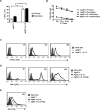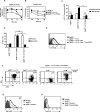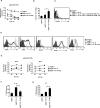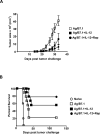The mTOR kinase determines effector versus memory CD8+ T cell fate by regulating the expression of transcription factors T-bet and Eomesodermin
- PMID: 20060330
- PMCID: PMC5836496
- DOI: 10.1016/j.immuni.2009.10.010
The mTOR kinase determines effector versus memory CD8+ T cell fate by regulating the expression of transcription factors T-bet and Eomesodermin
Abstract
The mechanisms underpinning integration of instructions that program naive CD8+ T cells for effector and/or memory differentiation are not well understood. Herein, we demonstrate that interleukin-12 (IL-12) enhanced and sustained antigen and costimulatory molecule (B7.1)-induced mTOR kinase activity in naive CD8+ (OT-I) T cells via phosphoinositide 3-kinase and STAT4 transcription factor pathways. Blocking mTOR activity by rapamycin reversed IL-12-induced effector functions because of loss of persistent expression of the transcription factor T-bet. Rapamycin treatment of IL-12-conditioned OT-I cells promoted persistent Eomesodermin expression and produced memory cell precursors that demonstrated enhanced sustenance and antigen-recall responses upon adoptive transfer. The memory cell precursors showed greater tumor efficacy than IL-12-conditioned effector OT-I cells. These results identify mTOR as the central regulator of transcriptional programs that determine effector and/or memory cell fates in CD8+ T cells. Targeting mTOR activity offers new opportunities to regulate CD8+ T cell-mediated immunity.
Copyright 2010 Elsevier Inc. All rights reserved.
Conflict of interest statement
The authors declare that they have no competing financial interests.
Figures







Similar articles
-
IL-12 Influence mTOR to Modulate CD8+ T Cells Differentiation through T-bet and Eomesodermin in Response to Invasive Pulmonary Aspergillosis.Int J Med Sci. 2017 Aug 18;14(10):977-983. doi: 10.7150/ijms.20212. eCollection 2017. Int J Med Sci. 2017. PMID: 28924369 Free PMC article.
-
Transcription factor Foxo1 represses T-bet-mediated effector functions and promotes memory CD8(+) T cell differentiation.Immunity. 2012 Mar 23;36(3):374-87. doi: 10.1016/j.immuni.2012.01.015. Epub 2012 Mar 15. Immunity. 2012. PMID: 22425248 Free PMC article.
-
Eomesodermin driven IL-10 production in effector CD8+ T cells promotes a memory phenotype.Cell Immunol. 2019 Jan;335:93-102. doi: 10.1016/j.cellimm.2018.11.008. Epub 2018 Dec 1. Cell Immunol. 2019. PMID: 30528350 Free PMC article.
-
The role of mTOR in memory CD8 T-cell differentiation.Immunol Rev. 2010 May;235(1):234-43. doi: 10.1111/j.0105-2896.2010.00898.x. Immunol Rev. 2010. PMID: 20536567 Free PMC article. Review.
-
mTOR signaling in the differentiation and function of regulatory and effector T cells.Curr Opin Immunol. 2017 Jun;46:103-111. doi: 10.1016/j.coi.2017.04.005. Epub 2017 May 20. Curr Opin Immunol. 2017. PMID: 28535458 Free PMC article. Review.
Cited by
-
mTOR is critical for intestinal T-cell homeostasis and resistance to Citrobacter rodentium.Sci Rep. 2016 Oct 12;6:34939. doi: 10.1038/srep34939. Sci Rep. 2016. PMID: 27731345 Free PMC article.
-
mTOR Regulation of Lymphoid Cells in Immunity to Pathogens.Front Immunol. 2016 May 11;7:180. doi: 10.3389/fimmu.2016.00180. eCollection 2016. Front Immunol. 2016. PMID: 27242787 Free PMC article. Review.
-
N-ras couples antigen receptor signaling to Eomesodermin and to functional CD8+ T cell memory but not to effector differentiation.J Exp Med. 2013 Jul 1;210(7):1463-79. doi: 10.1084/jem.20112495. Epub 2013 Jun 17. J Exp Med. 2013. PMID: 23776078 Free PMC article.
-
mTOR Modulates CD8+ T Cell Differentiation in Mice with Invasive Pulmonary Aspergillosis.Open Life Sci. 2018 May 4;13:129-136. doi: 10.1515/biol-2018-0018. eCollection 2018 Jan. Open Life Sci. 2018. PMID: 33817078 Free PMC article.
-
mTORC1 and mTORC2 selectively regulate CD8⁺ T cell differentiation.J Clin Invest. 2015 May;125(5):2090-108. doi: 10.1172/JCI77746. Epub 2015 Apr 20. J Clin Invest. 2015. PMID: 25893604 Free PMC article.
References
-
- Bettelli E, Oukka M, Kuchroo VK. T(H)-17 cells in the circle of immunity and autoimmunity. Nat Immunol. 2007;8:345–350. - PubMed
-
- Cham CM, Gajewski TF. Glucose availability regulates IFN-gamma production and p70S6 kinase activation in CD8+ effector T cells. J Immunol. 2005;174:4670–4677. - PubMed
-
- Cornish GH, Sinclair LV, Cantrell DA. Differential regulation of T-cell growth by IL-2 and IL-15. Blood. 2006;108:600–608. - PubMed
Publication types
MeSH terms
Substances
Grants and funding
LinkOut - more resources
Full Text Sources
Other Literature Sources
Molecular Biology Databases
Research Materials
Miscellaneous

